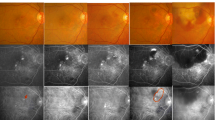Abstract
Purpose
To investigate the frequency and clinical features of polypoidal choroidal vasculopathy (PCV) in a consecutive series of elderly Chinese patients.
Methods
A restrospective analysis of 166 consecutive patients 50 years or older with diagnosis of exudative age-related macular degeneration (AMD) was conducted. Color fundus photographs were taken and fluorescein and indocyanine green (ICG) angiography were performed in all patients.
Results
Of the 166 patients, 37 patients (22.3%) initially suspected of having exudative AMD were ultimately diagnosed as having PCV. Twenty-seven men (73.0%) were affected, 32 patients (86.5%) were unilaterally involved. Of 42 eyes with PCV, 27 eyes (64.3%) demonstrated polypoidal dilations with branching vascular network, and the other 15 eyes (35.7%) showed scattered polypoidal dilations without identifiable continuous branching vascular network on ICG angiography. The predominant location for these lesions was at the macular region in 26 eyes (61.9%), the temporal vascular arcade in 9 eyes (21.4%), the peripapillary area in 6 eyes (14.3%), and the midperiphery in 1 eye (2.4%).
Conclusions
PCV is a common disease in elderly Chinese patients. In our study group PCV mainly affected men and was mostly unilateral. Most of the lesions were located in the macular region and temporal vascular arcade.


Similar content being viewed by others
References
Ahuja RM, Stanga PE, Vingerling JR, Reck AC, Bird AC (2000) Polypoidal polypoidal choroidal vasculopathy in exudative and haemorrhagic pigment epithelial detachments. Br J Ophthalmol 84:479–484
Guyer DR, Yanuzzi LA, Slakter JS, Sorenson JA, Hanutsaha P, Spaide RF, Schwartz SG, Hirschfeld JM, Orlock DA (1996) Classification of choroidal neovascularization by digital indocyanine green videoangiography. Ophthalmology 103:2054–2060
Kleiner RC, Brucker AJ, Johnston RL (1990) The posterior uveal bleeding syndrome. Retina 10:7–9
Kwok AKH, Lai TYY, Chan CWN, Neoh E-L, Lam DSC (2002) Polypoidal choroidal vasculopathy in Chinese patients. Br J Ophthalmol 86:892–897
Lafaut BA, Leys AM, Snyers B, Rasquin F, De Laey JJ (2002) Polypoidal choroidal vasculopathy in Caucasians. Graefes Arch Clin Exp Ophthalmol 238:752–759
Moorthy RS, Lyon AT, Rabb MF, Spaide RF, Yannuzzi LA, Jampol LM (1998) Idiopathic polypoidal choroidal vasculopathy in macular. Ophthalmology 105:1380–1385
Scassellati-Sforzolini B, Mariotti C, Bryan R, Yannuzzi LA, Giuliani M, Giovannini A (2001) Polypoidal choroidal vasculopathy in Italy. Retina 21:121–125
Shiraga F, Matsuo T, Yokoe S, Takasu I, Okannouchi T, Ohtsuki H, Grossniklaus H (1999) Surgical treatment of submacular hemorrhage associated with idiopathic polypoidal choroidal vasculopathy. Am J Ophthalmol 128:147–154
Spaide RF, Yannuzzi LA, Slakter JS, Sorensoon J, Orlock DA (1995) Indocyanine green videoangiography of idiopathic polypoidal choroidal vasculopathy. Retina 15:100–110
Stern RM, Zakov ZN, Zegarra H, Gutman FA (1985) Multiple recurrent serosanguineous retinal pigment epithelial detachments in black women. Am J Ophthalmol 1985:560–569
Uyama M, Matsubara T, Fukushima I, Matsunage H, Iwashita K, Nagai Y, Takahashi K (1999) Idiopathic polypoidal choroidal vasculopathy in Japanese patients. Arch Ophthalmol 117:1035–1042
Yannuzzi LA (1982) Idiopathic polypoidal choroidal vasculopathy. Presented at the Macula Society Meeting, 5 February 1982, Miami, Fla
Yannuzzi LA, Sorenson J, Spaide RF, Lipson B (1990) Idiopathic polypoidal choroidal vasculopathy. Retina 10:1–8
Yannuzzi LA, Ciadella A, Spaide RF, Rabb M, Freund B, Orlock DA (1997) The expanding clinical spectrum of idiopathic polypoidal choroidal vasculopathy. Arch Ophthalmol 115:478–485
Yannuzzi LA, Wong DWK, Scassellati-Sforzolini B, Goldbaum M, Tang KC, Spaide RF, Sorenson JA, Fisher Y, Maberley D, Orlock DA (1999) Polypoidal choroidal vasculopathy and neovascularized age-related macular degeneration. Arch Ophthalmol 117:1503–1510
Acknowledgements
This study was supported by the Medicinal Science Technology Research Fund of Guangdong Province (grant no. 96061) and supported in part by National Natural Science Foundation of China (grant no. 30271669).
Author information
Authors and Affiliations
Corresponding author
Rights and permissions
About this article
Cite this article
Wen, F., Chen, C., Wu, D. et al. Polypoidal choroidal vasculopathy in elderly Chinese patients. Graefe's Arch Clin Exp Ophthalmol 242, 625–629 (2004). https://doi.org/10.1007/s00417-003-0667-z
Received:
Revised:
Accepted:
Published:
Issue Date:
DOI: https://doi.org/10.1007/s00417-003-0667-z




